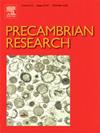Revisiting the geological evolution of the Brasília orogenic belt (Central Brazil) through the integration of tectonic and provenance studies
IF 3.2
2区 地球科学
Q2 GEOSCIENCES, MULTIDISCIPLINARY
引用次数: 0
Abstract
The tectonic evolution of ancient collisional orogenic systems can be unraveled using a variety of approaches, including systematic dating and geochemical analysis of pre- to post-collisional magmatic rocks, as well as the study of associated sedimentary basins. The Brasília Orogenic Belt in Central Brazil represents a critical component of the orogenic systems that formed during the assembly of West Gondwana in the Neoproterozoic to early Paleozoic. In this study, we present a reinterpreted tectonic map of the Brasília Orogenic Belt, integrated with regional tectonic sections and a comprehensive dataset of geochronological information. This work involved the compilation, integration, and reinterpretation of detailed and regional geological maps, new field data, seismic and geophysical maps, and hundreds of U-Pb detrital and direct ages from sedimentary successions. Two major tectonic components were recognized and improved: i) pre-orogenic sedimentary basins including a Paleoproterozoic rift, a Mesoproterozoic rift-sag and a Mesoproterozoic to Neoproterozoic rift-sag that evolved into a passive margin; and ii) Ediacaran to Cambrian syn-orogenic basins that include a forearc and a syn-collisional basin. Our data reveal a tectonic evolution pre-dated by multiple Proterozoic rifting episodes that evolved into an ocean-floored and passive margin basin in the Neoproterozoic. The tectonic convergence between the São Francisco and the Paranapanema and Amazonian palecontinents during the Neoproterozoic-early Paleozoic converted the passive margin into a complex accretionary system and, later on, into a collisional orogen. The tectonic architecture and evolution of the belt seem to have been also controlled by preexisting structures, which partially induced the development of contrasting elements in the northern and southern portions of the belt, as well as the preservation of contrasting geological records. Sedimentary provenance patterns observed on pre- to syn-orogenic basin-fill units reflect the availability of cratonic and orogenic sources and the tectonic evolution of individual depocenter. Our work provides new insights into the assembly of West Gondwana and improves our understanding of ancient mountain-building process documented in the geological record.
求助全文
约1分钟内获得全文
求助全文
来源期刊

Precambrian Research
地学-地球科学综合
CiteScore
7.20
自引率
28.90%
发文量
325
审稿时长
12 months
期刊介绍:
Precambrian Research publishes studies on all aspects of the early stages of the composition, structure and evolution of the Earth and its planetary neighbours. With a focus on process-oriented and comparative studies, it covers, but is not restricted to, subjects such as:
(1) Chemical, biological, biochemical and cosmochemical evolution; the origin of life; the evolution of the oceans and atmosphere; the early fossil record; palaeobiology;
(2) Geochronology and isotope and elemental geochemistry;
(3) Precambrian mineral deposits;
(4) Geophysical aspects of the early Earth and Precambrian terrains;
(5) Nature, formation and evolution of the Precambrian lithosphere and mantle including magmatic, depositional, metamorphic and tectonic processes.
In addition, the editors particularly welcome integrated process-oriented studies that involve a combination of the above fields and comparative studies that demonstrate the effect of Precambrian evolution on Phanerozoic earth system processes.
Regional and localised studies of Precambrian phenomena are considered appropriate only when the detail and quality allow illustration of a wider process, or when significant gaps in basic knowledge of a particular area can be filled.
 求助内容:
求助内容: 应助结果提醒方式:
应助结果提醒方式:


